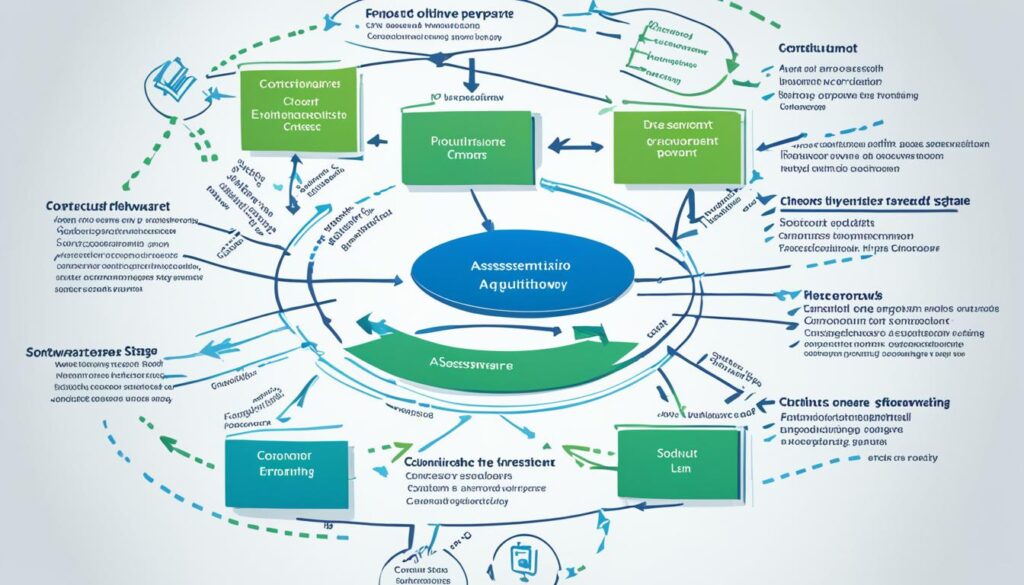The software acquisition pathway is a framework that enables organizations to rapidly and iteratively deliver software capabilities. With the increasing dependence on software in the Department of Defense (DoD), it is critical to ensure that software is created in a secure and controlled environment. The pathway emphasizes DevSecOps, continuous authorization to operate (cATO), and implementing the Risk Management Framework (RMF) at the speed of relevance. The objective is to deploy capability into operations within 6 months or less, with a goal of fielding capability into production on-demand. The DoD Instruction 5000.87 provides policy and procedures for the operation of the software acquisition pathway.
Key Takeaways:
- The software acquisition pathway enables rapid and iterative delivery of software capabilities.
- DevSecOps, continuous authorization to operate, and the Risk Management Framework are essential components of the pathway.
- The pathway aims to deploy capability into operations within 6 months or less.
- DoD Instruction 5000.87 provides policy and procedures for the operation of the software acquisition pathway.
- The pathway promotes secure and controlled software development in the Department of Defense.
Integrating Assess Only Construct in Software Acquisition Pathway Planning Phase
The Assess Only construct plays a vital role in the Planning Phase of the software acquisition pathway. It serves as a bridge between the acquisition pathway and the Risk Management Framework (RMF) team, ensuring compliance with cybersecurity requirements. This collaboration enables programs to identify suitable environments for software development and deployment, while also identifying common controls available to software.
By integrating the Assess Only construct during the Planning Phase, software acquisition activities are enhanced with cybersecurity risk management techniques and tools. This ensures that the software development and acquisition processes align with the necessary security measures.
This collaborative approach minimizes the software’s responsibility for mitigations, as it allows for the inherent security control mitigations provided by the environment. By leveraging the expertise of the RMF team, organizations can streamline the acquisition pathway and focus on delivering secure and robust software solutions.
The Benefits of Integrating Assess Only Construct in the Planning Phase:
- Strengthened cybersecurity: By incorporating cybersecurity requirements from the RMF team, software acquisition activities are fortified, minimizing potential vulnerabilities.
- Efficient utilization of resources: The collaborative effort between the acquisition pathway and the RMF team optimizes the allocation of resources, ensuring that software development and acquisition activities align with cybersecurity standards.
- Streamlined acquisition process: Integrating the Assess Only construct leads to improved coordination and communication between the acquisition pathway and the RMF team. This streamlines the overall software acquisition process.
Overall, the Assess Only construct is a crucial component of the Planning Phase in the software acquisition pathway. It enhances cybersecurity practices, enables efficient utilization of resources, and streamlines the acquisition process. By leveraging this construct, organizations can establish a strong foundation for secure and successful software acquisition and development.
Example Table: Evaluating Assess Only Construct Integration
| Benefits | Impact |
|---|---|
| Strengthened cybersecurity | Minimizes vulnerabilities and potential security breaches |
| Efficient resource utilization | Optimizes allocation of resources while ensuring compliance with cybersecurity requirements |
| Streamlined acquisition process | Improved coordination and communication between acquisition pathway and RMF team |

Execution Phase in Software Acquisition Pathway
The Execution Phase, an essential stage in the software acquisition pathway, encompasses the utilization of the Assess Only construct. This construct operates by conducting thorough evaluations of the software’s function, environment, quality control, and data usage. By leveraging the Assess Only construct, organizations can ensure that the software meets the necessary requirements and standards before proceeding further.
During this phase, the software is acquired and continuously integrated into operational environments. This integration process ensures that the system’s Security Plan and other relevant documentation are updated accordingly to reflect any changes or enhancements made. By keeping the software up-to-date, organizations can prioritize security and maintain a comprehensive understanding of the software’s features, functions, and potential risks.
Interaction between the software acquisition pathway team, the Risk Management Framework (RMF) team, and the responsible system authorizing official is of utmost importance during the Execution Phase. Transparent communication among these stakeholders fosters effective collaboration and enables secure software development. Regular meetings, feedback sessions, and information exchanges support the alignment of goals and the fulfillment of security requirements.
To ensure maximum software security and minimize potential vulnerabilities, the Execution Phase emphasizes the creation of a secure development environment. This environment incorporates automated testing and enforces coding standards, thereby promoting consistent quality and reducing the risk of security breaches. By establishing and adhering to these standards, organizations can confidently deliver software solutions that meet the highest security standards.
Key Takeaways:
- The Execution Phase of the software acquisition pathway involves the utilization of the Assess Only construct.
- Thorough reviews of the software’s function, environment, quality control, and data usage are conducted during this phase.
- Software is continuously integrated into operational environments, ensuring the Security Plan reflects the latest changes.
- Regular interaction between the software acquisition pathway team, RMF team, and the responsible system authorizing official is vital.
- A secure development environment with automated testing and coding standards enforcement is essential for software security.
Key Elements and Benefits of the Software Acquisition Pathway
The software acquisition pathway incorporates key elements of modern software development practices, fostering a more efficient and effective approach to procure software capabilities. By implementing human-centered design, actively engaging users, and leveraging enterprise services and platforms, organizations can unlock the full potential of the pathway.
In embracing a rapid and iterative delivery model, the software acquisition pathway allows for continuous improvement, ensuring that mission impact is maximized at every step. This agile approach enables organizations to quickly adapt and respond to changing requirements.
One of the key strengths of the pathway lies in its flexibility. With tailored acquisition processes for software development, organizations can address priority needs and critical risks first, optimizing the allocation of resources and minimizing potential vulnerabilities.
The benefits of the software acquisition pathway extend beyond increased speed and flexibility. By adopting this framework, organizations can experience the following advantages:
- Enhanced Speed: The pathway streamlines the software acquisition process, reducing bureaucratic hurdles and accelerating the delivery of software capabilities.
- Improved Flexibility: Organizations can pivot and adapt to evolving needs and requirements, ensuring the software solutions align with mission objectives.
- Heightened Rigor: The pathway emphasizes rigorous quality control processes, ensuring that delivered software meets the highest standards of performance, security, and reliability.
Incorporating the software acquisition pathway into an organization’s procurement strategy empowers them to unlock the benefits of modern software development practices, expedite software delivery, and maximize mission impact.
“The software acquisition pathway not only enables faster software delivery but also promotes a culture of continuous improvement, ensuring that organizations can stay ahead of emerging challenges and deliver software capabilities that meet user needs.”

Key Benefits of the Software Acquisition Pathway
| Benefits | Description |
|---|---|
| Enhanced Speed | The pathway streamlines the software acquisition process, reducing bureaucratic hurdles and accelerating software delivery. |
| Improved Flexibility | Organizations can adapt to changing needs and requirements, ensuring the software aligns with mission objectives. |
| Heightened Rigor | The pathway emphasizes rigorous quality control, ensuring software meets high standards of performance, security, and reliability. |
Conclusion
The software acquisition pathway provides a comprehensive framework for organizations to effectively and efficiently acquire and deliver software capabilities. By following this structured pathway, organizations can successfully navigate the complexities of software procurement, ensuring security and quality control, while meeting the evolving needs of the Department of Defense.
The pathway’s emphasis on modern software development practices, such as active user engagement and the use of enterprise services/platforms, allows for faster delivery of software solutions. By actively involving end-users throughout the development process, organizations can ensure that the software meets their needs and maximizes mission impact.
Furthermore, by leveraging enterprise services and adopting an iterative approach, the software acquisition pathway facilitates the delivery of software in a timely and efficient manner. This approach minimizes the need to rebuild the software factory and allows organizations to tailor the acquisition process to their specific software development needs.
In conclusion, the software acquisition pathway offers organizations a clear roadmap to acquire and deliver software capabilities effectively. By embracing this framework and its principles, organizations can streamline the software procurement process, enhance security and quality control measures, and ultimately meet the demands of the Department of Defense more efficiently.




